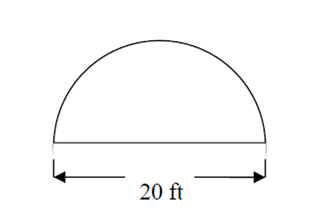saurya_s wrote:

The figure above shows the dimensions of a semicircular cross section of a one-way tunnel. The single traffic lane is 12 feet wide and is equidistant from the sides of the tunnel. If vehicles must clear the top of the tunnel by at least 1/2 foot when they are inside the traffic lane, what should be the limit on the height of vehicles that are allowed to use the tunnel?
A. 5 ½ ft
B. 7 ½ ft
C. 8 ½ ft
D. 9 ½ ft
E. 10 ft
We will translate the question from English to Math as we read it. This way, we’ll clearly get all that is given to us and that we need to find.
TIP: Simultaneous translation will help you understand a question in thorough detail and leave no scope for confusion as you progress through the solution.
Let’s go!
GIVEN – Understand the given information – TRANSLATE and VISUALIZE: - A one-way tunnel has a semicircular cross section.
- The given figure shows the diameter of the tunnel as 20 ft. So, the radius of the semicircular tunnel = 20/2 = 10 ft.
- A 12 ft wide traffic lane is equidistant from the sides of the tunnel.
- Say, the traffic lane is at an equal distance of x ft from both sides of the tunnel.
- Then x + 12 + x = 20.
- This implies x = 4.

- Any vehicle inside the lane MUST have a gap of at least ½ foot between the vehicle top and the ceiling of the tunnel.
- This distance is calculated for every point on the vehicle top to the point on the tunnel’s ceiling directly above.
I know this last bit seems confusing. Let’s
VISUALIZE this through some examples:
In the figure below, rectangle ABCD represents a vehicle passing through the tunnel. Suppose
‘h’ is the height of the vehicle (that is, AB = CD = h).

Required distance between vehicle and tunnel’s ceiling:
- At point A: Distance between point A on the top of the vehicle and point P on the tunnel’s ceiling directly above A = AP
- At point D: Distance between point D on the top of the vehicle and the point Q on the tunnel’s ceiling directly above D = DQ
- At point E (say, this is the midpoint of AD): Distance between point E on the top of the vehicle and the point R on the tunnel’s ceiling directly above E = ER
Now, per the question,
each of these distances needs to be at least ½ foot.
OBSERVE: AP < ER and similarly,
DQ < ER.
In fact, AP = DQ is the minimum distance between the vehicle and the tunnel. This is where the vehicle top will be the
closest to the tunnel’s ceiling.
So, if AP or DQ is >= ½ foot, then we can safely say that the vehicle’s top is always at least ½ foot away from the tunnel’s ceiling. ----(I)
TO FIND – Understand the question - TRANSLATE:- Limit on the height of the vehicles that are allowed inside the tunnel.
- That is, the maximum possible value of ‘h’.
SOLUTION: Now that we understand the question, finding the final answer will be easy. Let’s just bring back the figure we drew.
Visualize: 
As explained in (I), the gap between the vehicle’s top and the tunnel’s ceiling is minimum at the extreme points A and D on the top. So, if this minimum gap (AP) is at least ½ foot, then we’re done.
Observe that AP = BP –
h. Then, AP ≥ ½ implies that:
- BP – h ≥ ½.
- h ≤ BP – ½ ----(II)
So, we are left with finding
BP to get the required value of
h.
Finding the value of BP: Let us re-draw the above figure with only that is needed. Also, suppose the center of the tunnel/traffic lane is W, as shown.

Now, since triangle WBP is a right triangle, we just need the lengths of BW and WP to find BP.
- Since the traffic lane is given to be 12 ft wide, BC = 12.
- And since W is the center of the lane, BW = \(\frac{12}{2}\)= 6 ft. --- (III)
- Also, WP is nothing but the radius of the semicircular tunnel.
- So, WP = radius = 10 ft. --- (IV)
Finally, by applying the Pythagoras’ theorem on △WBP, we have:
\(WP^2 = BP^2 + WB^2\)
\(10^2 = BP^2 + 6^2\) (Using III and IV)
\(BP^2 \)= 100 – 36 = 64
So, BP
= 8 (As height cannot be negative) ----(V)
Finding the value of ‘h’: Using (II) and (V), we get:
So, the
maximum possible value of h is 7 ½ ft. That is, the maximum possible height of any vehicle that can pass through the tunnel while meeting the conditions given is 7 ½ ft.
Correct Answer: Option B Best,
Aditi Gupta
Quant expert,
e-GMAT



 65%
(hard)
65%
(hard)
 42%
(02:12)
wrong
42%
(02:12)
wrong  based on 1784
sessions
based on 1784
sessions





